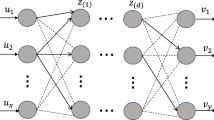Abstract
A new cyber infrastructure for rheology (CIR) has the potential of integrating the diverse rheological knowledge of experts around the world. In a multi-disciplinary effort, experts in specialized topics of rheology began to write CIR-modules that seamlessly merge into a general code so that it can be used by a wide range of engineers and scientists. At the center of CIR is a platform operating system that connects a wide range of dedicated software modules. These CIR-modules perform calculations and return the corresponding results to a central graphics screen. The computer platform allows the detailed analysis of experimental data, the communication of data, and the prediction of rheological material functions from a wide range of theories in rheology. Rheologists can access each other’s experimental results, make predictions with each other’s theories and simulate with each other’s computer codes. Through such collaboration, seemingly disparate theories and experimental observations can be linked and taken to their limits, thereby leading to unexpected insights and new questions. Beyond the pool of experts, CIR will draw industrial users into the rheology discussion. Easy-to-use CIR-tools will allow industrial rheologists to adjust rapidly to the changing needs and the pressure to obtain short-term solutions in a competitive environment. CIR has the potential of generating ideas for novel materials and novel manufacturing methods. At the same time, it will supply the tools to examine ideas quantitatively and to push these ideas even further. User-friendly methods are essential not only for research and application, but also for the teaching of rheology. We envision tools that allow a student to move seamlessly and rapidly between experimental data and the most advanced rheological theories, simulations, and modeling of applications. In-depth data analysis and evaluation of theory should become easy enough to be performed after reasonable training and without relying on over-simplifications. This will enable the student to reach a deeper understanding of rheology and to appreciate the significance that rheology has in technical applications. Even untrained talent may get introduced quickly into advanced concepts of rheology.




Similar content being viewed by others
References
Alkire RC, Ratner MA (2003) Information and communications: challenges for the chemical sciences in the 21st century. NSF publication (http://www.nap.edu/ catalog/10831.html)
Atkins DE, Droegemeier KK, Feldman SI, Garcia-Molina H, Klein ML, Messerschmitt DG, Messina P, Ostriker JP, Wright MH (2003) Revolutionizing science and engineering through cyberinfrastructure, NSF publication (http://www.cise.nsf.gov/ sci/reports/atkins.pdf)
Baumgärtel M, Winter HH (1989) Determination of the discrete relaxation and retardation time spectra from dynamic mechanical data. Rheol Acta 28:511–519
Blackwell RJ, Harlen OG, McLeish TCB (2001) Theoretical linear and nonlinear rheology of symmetric treelike polymer melts. Macromolecules 34:2579–2596
Cocchini F, Nobile MR (2003) Constrained inversion of rheological data to molecular weight distribution for polymer melts. Rheol Acta 42:232–242
Doi M (2003) Challenge in polymer physics. Pure Appl Chem 75:1395–1402
Masubuchi Y, Takimoto J, Koyama K, Ianniruberto G, Greco F, Marrucci G (2001) Brownian simulations of a network of reptating primitive chains. J Chem Phys 115:4387–4394
Masubuchi Y, Ianniruberto G, Greco F, Marrucci G (2003) Entanglement molecular weight and frequency response of sliplink networks. J Chem Phys 119:6925–6930
Masubuchi Y, Ianniruberto G, Greco F, Marrucci G (2004) Molecular simulations of longtime behavior of entangled polymeric liquids by the primitive chain network model, modelling simulation. Mat Sci Eng 12:91–100
McLeish TCB, Larson RG (1998) Molecular constitutive equations for a class of branched polymers: the pom-pom polymer. J Rheol 42: 81–110
McLeish TCB, Allgaier J, Bick DK, Bishko G, Biswas P, Blackwell R, Blottiere B, Clarke N, Gibbs B, Groves DJ, Hakiki A, Hoenan RK, Johnson JM, Kant R, Read DJ, Young RN (1999) Dynamics of entangled H-polymers: theory, rheology, and neutron scattering. Macromolecules 32:6734–6758
Milner ST, McLeish TCB (1997) Parameter-free theory for stress relaxation in star polymer melts. Macromolecules 30:2159–2166
Milner ST, McLeish TCB (1998) Reptation and contour-length fluctuations in melts of linear polymers. Phys Rev Lett 81:725–728
Mours M, Winter HH (1994) Time resolved rheometry. Rheol Acta 33:385–397
Mours M, Winter HH (1996) Relaxation patterns of nearly critical gels. Macromolecules 29:7221–7229
Mours M, Winter HH (2000) Mechanical spectroscopy. In: Tanaka T (ed) Experimental methods in polymer science: modern methods in polymer research and technology. Academic Press, San Diego, pp 495–546
Nobile MR, Cocchini F (2001) Evaluation of molecular weight distribution from dynamic moduli. Rheol Acta 40:111–119
Pryke A, Blackwell RJ, McLeish TCB, Young RN (2002) Synthesis, hydrogenation, and rheology of 1,2-polybutadiene star polymers. Macromolecules 35:467–472
Wagner MH, Yamaguchi M, Takahashi M (2003) Quantitative assessment of strain hardening of low-density polyethylene melts by the molecular stress function model. J Rheol 47:779–793
Acknowledgements
The rheology platform was developed with the help of licensing fees from its users. The development greatly benefited from suggestions of many rheologists (worldwide). Theory modules were written by Richard J. Blackwell (Tube Dilation Theory), Manfred H. Wagner (Molecular Stress Function Theory), and Rosella Nobile and Franco Cocchini (molecular weight determination). HHW is especially grateful for the 2004 Conti Faculty Fellowship that UMass Amherst awarded to him for establishing an interactive rheology course that utilizes the CIR tools in the classroom. The anonymous review was conducted by M.H. Wagner as member of the Rheologica Acta Editorial Board.
Author information
Authors and Affiliations
Corresponding author
Rights and permissions
About this article
Cite this article
Winter, H.H., Mours, M. The cyber infrastructure initiative for rheology. Rheol Acta 45, 331–338 (2006). https://doi.org/10.1007/s00397-005-0041-7
Received:
Accepted:
Published:
Issue Date:
DOI: https://doi.org/10.1007/s00397-005-0041-7




